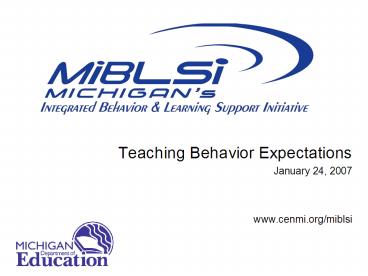Teaching Behavior Expectations - PowerPoint PPT Presentation
1 / 23
Title:
Teaching Behavior Expectations
Description:
'If a child doesn't know how to drive, we teach.' 'If a child doesn't know how to behave, we. ... Close to being examples of expected behavior rather than ... – PowerPoint PPT presentation
Number of Views:208
Avg rating:3.0/5.0
Title: Teaching Behavior Expectations
1
- Teaching Behavior Expectations
- January 24, 2007
- www.cenmi.org/miblsi
2
If a child doesnt know how to read, we teach.
If a child doesnt know how to swim, we teach.
If a child doesnt know how to multiply, we
teach. If a child doesnt know how to drive, we
teach. If a child doesnt know how to behave,
we..... .teach? punish?
Why cant we finish the last sentence as
automatically as we do the others?
Tom Herner (NASDE President ) Counterpoint 1998,
p.2)
3
Big Ideas In Positive Behavior Support
- Identify expectations
- Teach expectation
- Monitor expected behavior
- Acknowledge/Encourage expected behavior
- Correct behavioral errors (continuum of
consequences) - Use information for decision-making
4
Teach Behavioral Expectations
- Teach in the actual settings where behaviors are
to occur - Teach both
- the words
- the actions
- Build a social culture that is predictable, and
focused on student success.
5
Teaching Academics Behaviors
6
Contrasting Positive and Negative Examples of
Behavioral Expectations
- Purpose to help students better understand the
parameters of what is and what is not the
expected behavior - Choose examples that best fit the general case
of the behavior expectation - Choose nonexamples that are
- Close to being examples of expected behavior
rather than outrageous nonexamples - Typical of what students do when they are not
engaged in the expected behavior
7
Problem Only provide one positive example
This is zingle
Is this zingle?
Adapted from Engelmann S., Carnine, D. (1991).
Theory of instruction Principles and
applications. Eugene, OR ADI
8
Problem Only provide positive examples
This is zingle
Is this zingle?
This is zingle
This is zingle
Adapted from Engelmann S., Carnine, D. (1991).
Theory of instruction Principles and
applications. Eugene, OR ADI
9
Provide multiple examples and nonexamples
This is zingle
This is not zingle
This is zingle
This is not zingle
This is not zingle
This is zingle
Is this zingle?
Is this zingle?
10
Provide multiple examples and non-examples
This is not galoof
This is galoof
This is not galoof
This is galoof
This is not galoof
This is galoof
Is this galoof?
Is this galoof?
Adapted from Engelmann S., Carnine, D. (1991).
Theory of instruction Principles and
applications. Eugene, OR ADI
11
Process for Teaching Behavioral Expectations
- Define the Expectation
- Provide a Rationale
- Teach the Critical Discrimination
- Demonstrate Appropriate Behavior
- Demonstrate Unacceptable Behavior
- Practice telling the difference with multiple
examples - If there is a signal teach the signal (when
should the appropriate behavior occur?) - Have everyone practice the appropriate behavior
- Acknowledge students for demonstrating
appropriate behavior
12
Use Behavior Matrix to Create Behavior Lesson
Plans
13
Williamette High School Behavior Expectations
in Hallway
14
Expected Behavior Lesson PlanSample 1
15
Expected Behavior Lesson PlanSample 2
16
Team Work Time
- Use the Behavior Expectation Lesson Plan
worksheet to create your own lesson plan for
teaching behavior expectations
17
Traveling Passports
- Precorrecting new kids
- Procedures
- Meet with key adults
- Review expectations
- Go to next teaching location
18
Morning Announcement
- Students in Lansdowne High School Drama and
Broadcasting classes wrote and performed public
service announcements that have been played on
the morning announcements
19
When to Teach Rules
- Teaching Sessions
- Younger students 10- 15 minutes sessions
- Older students longer teaching sessions
- First week- every day
- First month- every Monday
- Throughout year- first day back from extended
vacations - When new person (student or staff) joins class
20
Other times we have found helpful
- Prior to an assembly or special program
- Prior to a substitute teacher coming
- Prior to a change in routine
- When data suggests a need for a refresher
21
Team Work Time
- Make a plan
- Develop a schedule/plan for initial teaching of
behaviors (consider rotating stations) - Use the Teaching Behavior Expectations Schedule
of Events Worksheet to develop a general schedule
or set of guidelines for refresher sessions.
22
Organizing a PBS Start to the YearSouth Range
All lesson plans, teaching matrix, flowcharts,
etc are provided to staff in one easy to use
binder
23
School-Wide Positive Behavior Support
Tertiary prevention focuses on reducing the
intensity and/or complexity of existing cases of
problem behavior that are resistant to primary
and secondary prevention efforts
Secondary prevention focuses on reducing the
number of existing cases of problem behaviors by
establishing efficient and rapid responses to
occurrences of problem behavior.
Primary prevention focuses on preventing the
development of new cases of problem behaviors by
focusing on all students and staff, across all
settings (i.e., school-wide, classroom, and
nonclassroom/ unstructured settings).
All Students

